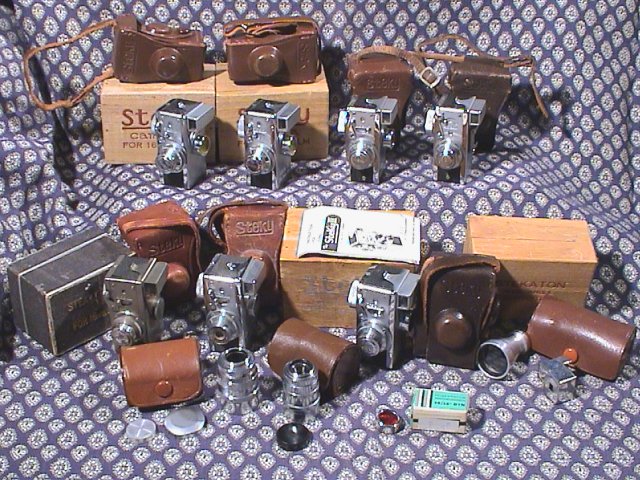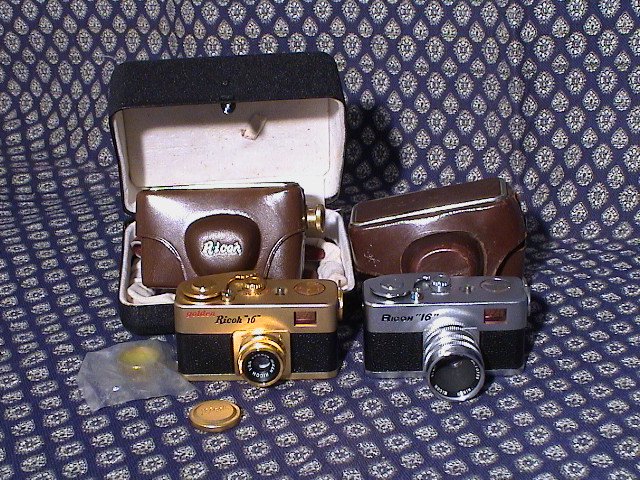

The Steky camera first appeared in 1947 as the first of several brick shaped subminiature cameras introduced by Asahi Musen Company of Tokyo. The Steky was straight forward and no one familiar with cameras in general would have trouble using it. It had a three element f/3.5 Stekinar Anastigmat lens which closed down to f/11. While the Steky's lens was factory set at about 12 feet, the usual fixed focus distance for 25mm lenses, changing apertures altered depth of field. Hence, at f/5.6 everything from 5 feet to infinity would be in focus.
At f/8, everything from 4 feet to infinity, and at f/11, everything from three and a half feet to infinity. A simple behind the lens shutter with speeds of 1/25, 1/50, 1/100 and B was set with a small knob on the camera front. The long lever on the camera face opposite the viewfinder tripped the shutter. With a top speed of 1/100 second, the camera had to be held absolutely steady.
The Steky's other features were equally ordinary. The viewfinder had plain optical glass. There was no double exposure prevention and the user advanced one to the next by winding a large knob on the side of the camera after pushing the little button which changed the film numbering dial, directly below the wind knob. The camera had a few nice touches. In addition to a cute leather case to protect the camera, a yellow filter fit on to the round protrusion below the viewfinder. Because the shutter, aperture setting and wind mechanisms were kept simple, Steky's are incredibly durable. It is rare to find one in poor operating condition.
In retrospect, it is easy to overlook how revolutionary the Steky was when it first appeared. For one thing, the Steky was the first Japanese camera to use 16mm roll film. At a time when all other small Japanese cameras used poor quality paper backed 17.5 roll film, the Steky made 10 x 14mm negatives on either single or double perforated 16mm film loaded into small metal cassettes.
Moreover the camera camera had an interchangeable lens mount identical in size and groove to that used on 8mm movie cameras. As a result many fine lenses, often with wide, f/1.9 apertures and in a focusing mount, could be used on the Steky. Indeed early reports indicated that owners were mounting other lenses on the camera and in 1950, Asahi Musen, which had changed its name to the Riken Optical Company, introduced a 40mm f/5.6 telephoto lens in a focusing mount. Soon thereafter Riken also introduced a faster f/32, 40mm telephoto lens as well as a 17mm wide angle converter lens which fit over the standard lens. Riken also supplied special viewfinders which , when clipped to the standard viewfinder, restricted or widened the field of view.
At the same time Riken also introduced the Steky 11, identical, except for minor cosmetic changes to the Steky 1. The Hanken Camera, extremely rare black police version of the Steky appeared in 1952, and in 1953, Riken introduced the Steky 111. This last camera was essentially similar to the model 1 and 11. However, the Stekinar lens which had been used on the Hanken, which closed down to f/16 rather than f/11, appeared on the Steky 111 as well. This small change helped compensate for the 1/100 second top shutter speed and provided a little more depth of field. A year later, in 1954, Riken introduced the 111A, the first Steky for flash. This model can be identified by the small single pole pc connection directly under the lens.
A year later, in 1955, Riken brought out the 111B which made a cosmetic change in the shutter setting dial but more important, replaced the filter holding knob with a conventional accessory shoe. Riken had discovered that owners of the 111A were thrilled to have flash synch capability but would have been happier to have some place to attach the flash unit to the camera. Steky cameras sold very well. Eventually Riken also introduced a flash gun, a transparency viewer and a special tripod, all of which demonstrated that a good if basic subminiature camera was economically viable and that after market accessories made the camera even more valuable.

The next chapter in the Steky biography came in 1957, when Riken introduced the Golden Steky, a name quickly changed to Golden Ricoh "16" in mid production. The Ricoh 16, both in a chrome and all black version came soon thereafter. This second generation of small Riken cameras represented a whole new approach to subminiature camera design and was necessary in order to compete with new Mamiya and Minolta subminiature cameras with newer lenses, faster shutters, and a new cassette film loading system. After a short ten years, the humble Steky was obsolete. c-1955